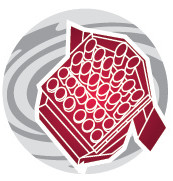|
|
|
Final programWednesday, October 24, 2018 09:00 - 09:30 The PLATO mission - Don Pollacco/Heike Rauer 09:30 - 13:00 Session: Impacts of stellar activity on planet detection and candidate ranking - Chair: Juan Cabrera 09:30 - 10:05 Planet detection in presence of stellar noise, review of methods - Sascha Grziwa (invited) 10:05 - 10:35 The Variable Variability of Stars: Four Years of Kepler - David Ciardi 10:35 - 10:55 Coffee break 10:55 - 11:30 the Impact of Stellar Variability on the Detection of Transiting Earth-like Planets - Jon Jenkins 11:30 - 12:00 Detection of extrasolar moons in the presence of stellar variability - Rene Heller 12:00 - 12:30 Discussion 12:30 - 14:00 Lunch break
14:00 - 18:00 Session: Planet characterization in presence of stellar activity - Chair: Szilard Csizmadia 14:00 - 14:35 Characterization of long-period small planets in presence of stellar activity - Susana Barros (invited) 14:35 - 15:05 Robust Transiting Exoplanet Radii in the Presence of Starspots - Morris Brett 15:35 - 16:10 Stellar oscillation and planet characterization: what asteroseismology can do for small planet characterization - Vincent Van Eylen (invited) 16:10 - 16:30 Coffee break 16:30 - 17:00 Stellar ages and planetary evolution: the CHRONOS initiative - David Barrado 17:00 - 17:30 Advantages of the multicolour photometry in characterisation of exoplanets - Valeriy Vasilyev 17:30 - 17:50 Measuring starspot physical properties with Kepler/K2 and high resolution near IR spectroscopy - Michael Gully-Santiago 17:50 - 18:20 Discussion
--------------------------------------------------------------- End of day 1 ------------------------------------------------------------------ Thursday, October 25, 2018 09:00 - 12:30 Session: Theory and modelling of stellar activity and variability - Chair: Isabella Pagano 09:00 - 09:30 Methods to remove stellar activity for planet detection - Suzanne Aigrain (invited) 09:30 - 10:00 Space-borne photometry, stellar activity, and small planets - Nuccio Lanza (invited) 10:00 - 10:20 TOSC: an algorithm for the tomography of spotted transit chords - Gaetano Scandariato 10:20 - 10:40 Coffee break 10:40 - 11:10 Modelling stellar activity and its effects on planet detection - Yvonne Unruh (invited) 11:10 - 11:40 Applying results on stellar variability from convection simulations to exoplanet detection - Heather Cegla (invited) 11:40 - 12:00 Testing the GPS method in the Sun as a Kepler Star - Eliana M. Amazo-Gómez 12:00 - 13:30 Lunch break
13:30 - 13:50 Understanding the Sun to discover Earth-twin planets with the HARPS-N Solar Telescope - Luca Malavolta 13:50 - 14:10 Three years of solar radial velocities on the approach to solar minimum - Andrew Collier-Cameron 14:10 - 14:45 Discussion 14:45 - 18:00 Session: Effect of stellar activity on planetary evolution and habitability - Chair: Richard Nelson 14:45 - 15:15 Evolution of primary H/He atmospheres due to stellar activity - Christoph Mordasini (invited) 15:15 - 15:45 Stellar activity as a driving force behind the loss processes from atmospheres of terrestrial planets - Kristina Kislyakova (invited) 15:45 - 16:10 Coffee break 16:10 - 16:40 Effect of stellar variability on terrestrial planet atmospheres - Lee Grenfell (invited) 16:40 - 17:00 Atmospheric characterization of exoplanets around active stars - Sara Khalafinejad 17:00 - 17:20 Radial Velocity support to K2 and TESS - David Armstrong 17:20 - 18:00 Discussion
--------------------------------------------------------------- End of day 2 ------------------------------------------------------------------ Friday, October 26, 2018 09:00 - 10:45 Session: Radial Follow-up : lessons learned and strategy to mitigate stellar effects - Chair Alexandre Santerne 09:00 - 09:20 Radial Velocity in support to K2 and TESS data - Davide Gandolfi 09:20 - 9:40 High precision ir spectroscopy for RV studies - Ignasi Ribas 9:40 - 10:00 Detecting Radial Velocity Variations due to Starspot Jitter in the CARMENES Survey for Exoplanets - Sepideh Sadegi 10:00 - 12:40 Session: New RV facilities and new stellar effects diagnostics 10:00 - 10:30 SPIROU new spectropolarimeter - Jean-François Donati 10:30 - 11:00 Coffee break 11:00 - 11:30 ESPRESSO at the level of 10 cm/s - Francesco Pepe 11:30 - 11:50 Strongly mitigating the stellar activity signal in radial velocity - Xavier Dumusque 11:50 - 12:10 PLATOSPec new RV follow-up facility - Petr Kabath 12:10 - 12:40 Discussion 12:40-14:00 Lunch break
14:00 - 14:30 The effect of stellar variability on characterizing exoplanet atmospheres with high resolution spectroscopy - Jayne Birkby 14:30 - 15:00 The effect of stellar variability on characterizing exoplanet atmospheres with transmission and emission spectroscopy from space - Jean-Michel Desert 15:00 - 15:20 Stellar contributions to the line profiles of high-resolution transmission spectra of exoplanets - Francesco Borsa 15:20 - 15:40 Disentangling the albedo of the exoplanet from the stellar activity - Luisa Maria Serrano 15:40 - 16:40 Discussion / Summary / Next steps / Conclusions --------------------------------------------------------------- End of the workshop ------------------------------------------------------------------ |


